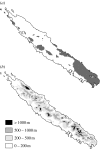New Caledonia: a very old Darwinian island?
- PMID: 18765357
- PMCID: PMC2607381
- DOI: 10.1098/rstb.2008.0122
New Caledonia: a very old Darwinian island?
Abstract
New Caledonia has generally been considered a continental island, the biota of which largely dates back to Gondwanan times owing to its geological origin and the presence of phylogenetic relicts. This view is contradicted by geological evidence indicating long Palaeocene and Eocene submersions and by recent biogeographic and phylogenetic studies, with molecular or geophysical dating placing the biota no older than the Oligocene. Phylogenetic relicts do not provide conclusive information in this respect, as their presence cannot be explained by simple hypotheses but requires assumption of many ad hoc extinction events. The implication of this new scenario is that all the New Caledonian biota colonized the island since 37 Ma Local richness can be explained by local radiation and adaptation after colonization but also by many dispersal events, often repeated within the same groups of organisms. Local microendemism is another remarkable feature of the biota. It seems to be related to recent speciation mediated by climate, orography, soil type and perhaps unbalanced biotic interactions created by colonization disharmonies. New Caledonia must be considered as a very old Darwinian island, a concept that offers many more fascinating opportunities of study.
Figures


References
-
- Aitchison J.C, Clarke L, Meffre S, Cluzel D. Eocene arc-continent collision in New Caledonia and implications for regional southwest Pacific tectonic evolution. Geology. 1995;23:161–164. doi:10.1130/0091-7613(1995)023<0161:EACCIN>2.3.CO;2 - DOI
-
- Aitchison J.C, Ireland T.R, Clarke G.L, Cluzel D, Davis A.M, Meffre S. Regional implications of U/Pb SHRIMP age constraints on the tectonic evolution of New Caledonia. Tectonophysics. 1998;299:333–343. doi:10.1016/S0040-1951(98)00211-X - DOI
-
- Antoine P.O, et al. Amber from western Amazonia reveals Neotropical diversity during the Middle Miocene. Proc. Natl Acad. Sci. USA. 2006;103:13 595–13 600. doi:10.1073/pnas.0605801103 - DOI - PMC - PubMed
-
- Balke M, Ribera I, Vogler A.P. MtDNA phylogeny and biogeography of Copelatinae, a highly diverse group of tropical diving beetles (Dysticidae) Mol. Phylogenet. Evol. 2004;32:866–880. doi:10.1016/j.ympev.2004.03.014 - DOI - PubMed
-
- Balke M, Pons J, Ribera I, Sagata K, Vogler A.P. Infrequent and unidirectional colonization of hyperdiverse Papuadytes diving beetles in New Caledonia and New Guinea. Mol. Phylogenet. Evol. 2007a;42:505–516. doi:10.1016/j.ympev.2006.07.019 - DOI - PubMed
Publication types
MeSH terms
LinkOut - more resources
Full Text Sources

